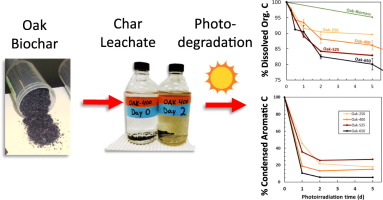当前位置:
X-MOL 学术
›
Sci. Total Environ.
›
论文详情
Our official English website, www.x-mol.net, welcomes your
feedback! (Note: you will need to create a separate account there.)
Photolability of pyrogenic dissolved organic matter from a thermal series of laboratory-prepared chars.
Science of the Total Environment ( IF 8.2 ) Pub Date : 2020-03-27 , DOI: 10.1016/j.scitotenv.2020.138198 Kyle W Bostick 1 , Andrew R Zimmerman 1 , Aleksandar I Goranov 2 , Siddhartha Mitra 3 , Patrick G Hatcher 2 , Andrew S Wozniak 4
Science of the Total Environment ( IF 8.2 ) Pub Date : 2020-03-27 , DOI: 10.1016/j.scitotenv.2020.138198 Kyle W Bostick 1 , Andrew R Zimmerman 1 , Aleksandar I Goranov 2 , Siddhartha Mitra 3 , Patrick G Hatcher 2 , Andrew S Wozniak 4
Affiliation

|
While pyrogenic dissolved organic matter (pyDOM) is known to be photolabile, the rates and components of pyDOM that are lost via photochemical degradation, and how these vary with pyrogenic source, are poorly understood. Thus, pyDOM was leached from an oak thermal series and a grass chars (250-650 °C) and photoirradiated in a solar simulator. About 10-20% of oak char leachate organic C was mineralized over five days, with greater proportions lost from leachates of higher temperature parent chars. Ultraviolet and fluorescence spectroscopy suggested that mainly aromatic components (e.g., fulvic-, humic-, aromatic-like) were lost. Quantification of benzenepolycarboxylic acids (BPCAs), molecular markers indicated that 75-94% of condensed aromatic C was lost during the first five days of photoincubation, with preferential loss of larger aromatic clusters. Using a 2-component exponential decay model, this most photolabile fraction was calculated to have experimental half-lives of about 1 day. It represented 16 to 23% of the dissolved C, was primarily condensed aromatics, and was likely lost through primary photoreactions. A non-condensed component was lost at half-lives of about 1-2 d, likely through radical-driven propagation reactions. Using the same model, about 43% of pyrogenic C was predicted to be photomineralized over the course of 1 year. These results highlight the contrasting reactivity of condensed and non-condensed portions of pyDOM, and both should be considered when evaluating the potential of pyDOM to alter aquatic ecology and the environmental mobility of priority pollutants.
中文翻译:

热系列实验室制备的焦炭中热解性溶解有机物的光化性。
尽管已知热解性溶解有机物(pyDOM)具有光不稳定性,但人们对通过光化学降解而损失的pyDOM的速率和成分以及它们随热解源的变化知之甚少。因此,从橡木热系列和草炭(250-650°C)中浸出了pyDOM,并在太阳模拟器中对其进行了光辐射。五天之内,约有10-20%的橡木炭渗滤液有机C矿化,高温母炭渗滤液损失的比例更大。紫外线和荧光光谱表明,主要丢失了芳族成分(例如富维酸,腐殖酸,类似芳族的成分)。定量苯酚羧酸(BPCA)的分子标记表明,在光孵化的前五天内损失了75-94%的缩合芳烃C,优先损失较大的芳香族簇。使用2组分指数衰减模型,计算出最不稳定的部分具有约1天的实验半衰期。它占溶解的C的16%到23%,主要是缩合的芳族化合物,很可能由于一次光反应而损失掉。可能通过自由基驱动的传播反应,在大约1-2 d的半衰期中损失了未凝结的组分。使用相同的模型,预计约有43%的热解碳在1年的时间内会被光矿化。这些结果突出了pyDOM的浓缩和非浓缩部分的对比反应性,在评估pyDOM改变水生生态和优先污染物的环境迁移率的潜力时,应同时考虑两者。计算出最不稳定的部分具有约1天的实验半衰期。它占溶解的C的16%到23%,主要是缩合的芳族化合物,很可能由于一次光反应而损失掉。可能通过自由基驱动的传播反应,在大约1-2 d的半衰期中损失了未凝结的组分。使用相同的模型,预计约有43%的热解碳在1年的时间内会被光矿化。这些结果突出了pyDOM的浓缩和非浓缩部分的对比反应性,在评估pyDOM改变水生生态和优先污染物的环境迁移性的潜力时,应同时考虑两者。计算出最不稳定的部分具有约1天的实验半衰期。它占溶解的C的16%到23%,主要是缩合的芳族化合物,很可能由于一次光反应而损失掉。可能通过自由基驱动的传播反应,在大约1-2 d的半衰期中损失了未凝结的组分。使用相同的模型,预计约有43%的热解碳在1年的时间内会被光矿化。这些结果突出了pyDOM的浓缩和非浓缩部分的对比反应性,在评估pyDOM改变水生生态和优先污染物的环境迁移率的潜力时,应同时考虑两者。主要是缩合的芳族化合物,很可能由于主要的光反应而丢失。可能通过自由基驱动的传播反应,在约1-2 d的半衰期中损失了未凝结的组分。使用相同的模型,预计约有43%的热解碳在1年的时间内会被光矿化。这些结果突出了pyDOM的浓缩和非浓缩部分的对比反应性,在评估pyDOM改变水生生态和优先污染物的环境迁移率的潜力时,应同时考虑两者。主要是缩合的芳族化合物,很可能由于主要的光反应而丢失。可能通过自由基驱动的传播反应,在大约1-2 d的半衰期中损失了未凝结的组分。使用相同的模型,预计约有43%的热解碳在1年的时间内会被光矿化。这些结果突出了pyDOM的浓缩和非浓缩部分的对比反应性,在评估pyDOM改变水生生态和优先污染物的环境迁移率的潜力时,应同时考虑两者。
更新日期:2020-03-27
中文翻译:

热系列实验室制备的焦炭中热解性溶解有机物的光化性。
尽管已知热解性溶解有机物(pyDOM)具有光不稳定性,但人们对通过光化学降解而损失的pyDOM的速率和成分以及它们随热解源的变化知之甚少。因此,从橡木热系列和草炭(250-650°C)中浸出了pyDOM,并在太阳模拟器中对其进行了光辐射。五天之内,约有10-20%的橡木炭渗滤液有机C矿化,高温母炭渗滤液损失的比例更大。紫外线和荧光光谱表明,主要丢失了芳族成分(例如富维酸,腐殖酸,类似芳族的成分)。定量苯酚羧酸(BPCA)的分子标记表明,在光孵化的前五天内损失了75-94%的缩合芳烃C,优先损失较大的芳香族簇。使用2组分指数衰减模型,计算出最不稳定的部分具有约1天的实验半衰期。它占溶解的C的16%到23%,主要是缩合的芳族化合物,很可能由于一次光反应而损失掉。可能通过自由基驱动的传播反应,在大约1-2 d的半衰期中损失了未凝结的组分。使用相同的模型,预计约有43%的热解碳在1年的时间内会被光矿化。这些结果突出了pyDOM的浓缩和非浓缩部分的对比反应性,在评估pyDOM改变水生生态和优先污染物的环境迁移率的潜力时,应同时考虑两者。计算出最不稳定的部分具有约1天的实验半衰期。它占溶解的C的16%到23%,主要是缩合的芳族化合物,很可能由于一次光反应而损失掉。可能通过自由基驱动的传播反应,在大约1-2 d的半衰期中损失了未凝结的组分。使用相同的模型,预计约有43%的热解碳在1年的时间内会被光矿化。这些结果突出了pyDOM的浓缩和非浓缩部分的对比反应性,在评估pyDOM改变水生生态和优先污染物的环境迁移性的潜力时,应同时考虑两者。计算出最不稳定的部分具有约1天的实验半衰期。它占溶解的C的16%到23%,主要是缩合的芳族化合物,很可能由于一次光反应而损失掉。可能通过自由基驱动的传播反应,在大约1-2 d的半衰期中损失了未凝结的组分。使用相同的模型,预计约有43%的热解碳在1年的时间内会被光矿化。这些结果突出了pyDOM的浓缩和非浓缩部分的对比反应性,在评估pyDOM改变水生生态和优先污染物的环境迁移率的潜力时,应同时考虑两者。主要是缩合的芳族化合物,很可能由于主要的光反应而丢失。可能通过自由基驱动的传播反应,在约1-2 d的半衰期中损失了未凝结的组分。使用相同的模型,预计约有43%的热解碳在1年的时间内会被光矿化。这些结果突出了pyDOM的浓缩和非浓缩部分的对比反应性,在评估pyDOM改变水生生态和优先污染物的环境迁移率的潜力时,应同时考虑两者。主要是缩合的芳族化合物,很可能由于主要的光反应而丢失。可能通过自由基驱动的传播反应,在大约1-2 d的半衰期中损失了未凝结的组分。使用相同的模型,预计约有43%的热解碳在1年的时间内会被光矿化。这些结果突出了pyDOM的浓缩和非浓缩部分的对比反应性,在评估pyDOM改变水生生态和优先污染物的环境迁移率的潜力时,应同时考虑两者。











































 京公网安备 11010802027423号
京公网安备 11010802027423号